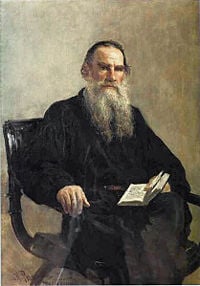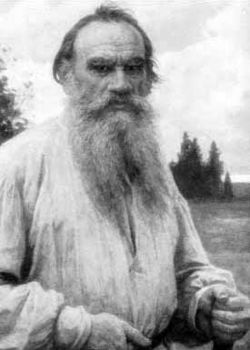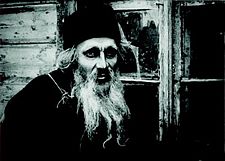Leo Tolstoy
Count Lev Nikolayevich Tolstoy (Russian: Лев Никола́евич Толсто́й; commonly referred to in English as Leo Tolstoy) (September 9, 1828 – November 20, 1910) was a Russian novelist, social reformer, pacifist, Christian anarchist, and moral thinker. Tolstoy is widely regarded as one of the greatest of all novelists, particularly noted for his masterpieces War and Peace and Anna Karenina. In their scope, breadth, insight into human motives, and realistic depiction of Russian life, these two books stand at the summit of realistic fiction.
In his later writings he distanced himself from realism as an aesthetic goal. Tormented between a strict religious temperament and his sensual cravings, Tolstoy came to embrace a life of personal austerity based on Christian love and an idealized image of the Russian peasantry. His later fiction is informed by a more didactic tone, and he turned increasingly to essays and treatises. In his book What is Art? (1898) Tolstoy condemned Shakespeare, Beethoven, and Dante, arguing that art has as its purpose the transmission of the highest and best feelings to encourage good actions.
Following the pacifist doctrine of nonresistance he found in the Christian Gospels, Tolstoy rejected all forms of coersion, both in government and in the church, leading to his excommunication from the Russian Orthodox Church in 1901. In a final dramatic act, the 83-year-old count renounced his rank and privileges, giving his estate to his family; he donned the garb of a Russian peasant, and set out on foot, trusting to inspiration. He caught a chill soon after and, with the world press arriving to report on the remarkable event, died at the railroad stationmaster’s house at Astapovo on November 20, 1910.
Tolstoy's stature as a literary master and his uncompromising advocacy of nonviolence expanded his reputation in Russia and abroad, and his estate became a place of pilgrimage. As a moral philosopher his ideas on nonviolent resistance in his work The Kingdom of God is Within You, influenced such twentieth-century figures as Mahatma Gandhi and Martin Luther King, Jr.
Early life
Tolstoy was born at Yasnaya Polyana, his family estate situated in the region of Tula, Russia. He was the fourth of five children in his family. His parents died when he was young, so he was brought up by relatives. Tolstoy studied law and Oriental languages at Kazan University in 1844, but never earned a degree. He returned in the middle of his studies to Yasnaya Polyana, and spent much of his time in Moscow and Saint Petersburg. After contracting heavy gambling debts, Tolstoy accompanied his elder brother to the Caucasus in 1851 and joined the Russian Army. Tolstoy began writing literature around this time. In 1862 he married Sofia Andreevna Bers, and together they had 13 children.
His marriage became progressively more difficult. It has been described by A.N. Wilson as one of the unhappiest in literary history, marked from the outset by Tolstoy's decision on the eve of his marriage to give his diaries to his fiancée. These detailed Tolstoy's sexual relations with his serfs. His relationship with his wife further deteriorated as his beliefs became increasingly radical.
Early works
Tolstoy was one of the giants of nineteenth-century Russian literature. Among his most famous works are the novels War and Peace and Anna Karenina, and many shorter works including the novellas The Death of Ivan Ilych and Hadji Murad. His contemporaries paid him lofty tributes: Dostoevsky thought him the greatest of all living novelists. His other admirers included Gustave Flaubert, Virginia Woolf, and Thomas Mann.
His first publications, the autobiographical novels, Childhood, Boyhood, and Youth (1852–1856), tell of a rich landowner's son and his slow realization of the differences between him and his peasant playmates. Although later in his life Tolstoy rejected these books as sentimental, a great deal of his own life is revealed, and the books are still recognized for their contribution to the coming-of-age genre.
Tolstoy served as a second lieutenant in an artillery regiment during the Crimean War, recounted in his Sevastapol Sketches. His experiences in battle helped develop his pacifist beliefs, and gave him material for the realistic depiction of the horrors of war in his later work.
His fiction is one of the greatest examples of the genre of realism. Realism is a literary technique that uses detailed verbal descriptions of places and things to imply attributes of character. Tolstoy’s description of Russian aristocratic society, like the lavish restaurant scene between Levin and Count Oblonsky in Anna Karenina, is unparalleled.
War and Peace
War and Peace is generally thought to be one of the greatest novels ever written, although Tolstoy did not consider War and Peace to be a novel, but an epic in prose. Remarkable for its breadth and unity, its vast canvas includes 580 characters, many historical, and others fictional. Its depiction of the battle scenes are noteworthy for Tolstoy's narrative technique, which would come to be known as ostranenie, or "making it strange." Tolstoy deliberately explains ordinary, customary, or usual phenomena as though they were extraordinary, exceptional, or unusual. (Victor Shklovsky, formalist literary critic developed this notion in a famous essay.)
The story moves from family life to the headquarters of Napoleon, from the court of Alexander I of Russia to the battlefields of Austerlitz and Borodino. It follows the lives and fate of a group of aristocratic families—the Rostovs, the Bolkonskys, the Kuragins and the Drubetskoys—although the central character that emerges is Pierre Bezukhov, the illegitimate son and heir of the wealthy Count Cyril Bezukhov. Tolstoy began writing in 1863 and did not finish until 1869. The general tenor of the novel is patriotic, anti-Napoleonic. It portrays a united front against the invader that belies some of the historical tensions that existed, including some peasant uprisings and sympathy for Napoleon on the part of some liberals.
The novel was written with the purpose of exploring Tolstoy's theory of history, which ironically in a novel dedicated to the Napoleonic Wars, rejected the significance of individuals such as Napoleon and Alexander in the greater scheme of things. Tolstoy rejects the “great man” theory of history in favor of the view that larger, more impersonal forces are at work. As a counterpoint to the dominant figure of Napoleon, Tolstoy introduces into the novel the peasant philosopher, Platon Karataev. Pierre Bezukhov comes across Platon (clearly an allusion to the Greek philosopher Plato) when he is captured by the French. While in prison together, Platon, a long-time soldier, tells him a story that would anticipate some of Tolstoy's later pacifist and quietist beliefs. Karataev, while apparently insignificant, serves as the spiritual center of the novel.
Anna Karenina
Tolstoy thought that Anna Karenina was his first true novel, and it is ranked as one of the greatest of all realist novels. Anna Karenina (1877) begins with one of the most famous opening lines in literature, “Happy families are all alike; every unhappy family is unhappy in its own way.” Anna Karenina tells parallel stories of two families, one happy and one unhappy. The Shcherbatskys are the happy therefore "good" family. Dolly is married to the amiable, but philandering Oblonsky. Her sister, Kitty, after being spurned by Count Vronsky, marries Count Levin and learns to be happy. Levin, a landowner, an alter-ego of Tolstoy, works alongside his serfs in the fields and seeks to reform their lives.
Anna, a striking beauty married to an older, high-ranking government official, Alexei Karenina, is trapped in a loveless marriage. She feels confined by the conventions and falsities of society. She falls in love with Count Vronsky and leaves her husband and son to live the life of a mistress. Anna Karenina is a closed moral universe. Her action against not only the prevailing social mores, but against the natural order at work in the novel, dooms her in the end. When she throws herself under a train and dies near the end of the narrative, it is already a foregone conclusion. Her situation has become so completely untenable that it is not so much a question of what she will do, but when.
After his two great novels, Tolstoy wrote a number of first-rate short stories, including The Death of Ivan Ilich, The Kreutzer Sonata, and Master and Man. In The Death of Ivan Ilyich (1886) Tolstoy addressed a theme that personally haunted him, death. Not long after, he underwent a spiritual crisis and transformation. This is evident in his later works which often took the form of folk tales and moral aphorisms, such as What Then Must We Do? and How Much Land Does One Man Need? In turn, he developed a radical anarcho-pacifist Christian philosophy which led to his excommunication from the Orthodox Church in 1901.
Theory of Art
After Tolstoy’s religious conversion, his view of art also changed dramatically. His book on art, What is Art? is an iconoclastic treatment that dismisses much of the canons of Western art. The proper role of art, he concluded, is to inspire moral vision in its audience. Not surprisingly, he reserved his strongest invective for modern art, which emphasized artifice and the formal properties of the artistic medium over the message. Modern art was artificial, not spontaneous, and thus immoral in Tolstoy’s interpretation. Ironically, by his new standards, much of his own work did not qualify as true art, including the novels for which he is beloved. Even Shakespeare did not escape criticism in Tolstoy’s moral aestheticism.
Religious and Political Beliefs

Tolstoy's Christian beliefs were based on the Sermon on the Mount, and particularly on the comment about turning your cheek, which he saw as a justification for pacifism. These beliefs came out of a middle-aged crisis that began with a depression so severe that if he saw a rope he would remark that it made him think of hanging himself, and which forced him to hide his guns to prevent himself from committing suicide.
Yet, this depression led Tolstoy to a radical and original approach to Christianity. He rejected the institution of the church in favor of a more personalized orientation. His belief in nonviolence as a positive feature of Jesus’ teaching characterized his beliefs. By directly influencing Mahatma Gandhi and Martin Luther King, Jr. with this idea through his work The Kingdom of God is Within You, Tolstoy has had a huge influence on nonviolent resistance to this day. Although himself an aristocrat, he came to believe that the aristocracy posed a burden on the poor. He embraced some elements of anarchism, such as the abolition of private property and the institution of marriage. Although he led a profligate youth, he came to value the ideals of chastity and sexual abstinence as discussed in Father Sergius. He was not only a pacifist but also a vegetarian.
Influence
As well as pacifism, Tolstoy had a profound influence on the development of Christian anarchism and anarchist thought. Prince Peter Kropotkin wrote of him in the article on Christian anarchism in the 1911 Encyclopedia Britannica:
Without naming himself an anarchist, Leo Tolstoy, like his predecessors in the popular religious movements of the fifteenth and sixteenth centuries, Chojecki, Denk, and many others, took the anarchist position as regards the state and property rights, deducing his conclusions from the general spirit of the teachings of Jesus and from the necessary dictates of reason. With all the might of his talent he made (especially in The Kingdom of God is Within You) a powerful criticism of the church, the state and law altogether, and especially of the present property laws. He describes the state as the domination of the wicked ones, supported by brutal force. Robbers, he says, are far less dangerous than a well-organized government. He makes a searching criticism of the prejudices which are current now concerning the benefits conferred upon men by the church, the state and the existing distribution of property, and from the teachings of Jesus he deduces the rule of non-resistance and the absolute condemnation of all wars. His religious arguments are, however, so well combined with arguments borrowed from a dispassionate observation of the present evils, that the anarchist portions of his works appeal to the religious and the non-religious reader alike.
A letter Tolstoy wrote to an Indian newspaper entitled "A Letter to a Hindu" resulted in a long-running correspondence with Mohandas Gandhi, who was at the time a young activist in South Africa. The correspondence with Tolstoy strongly influenced Gandhi towards adopting the method of nonviolent resistance. Through Gandhi, Tolstoy also influenced a young Martin Luther King, Jr. and the American Civil Rights Movement. He also became a major supporter of the Esperanto movement. Tolstoy was impressed by the pacifist beliefs of the Doukhobors* and brought their persecution to the attention of the international community after they burned their weapons in peaceful protest in 1895. He aided the Doukhobors in migrating to Canada.
In 1904, during the Russo-Japanese War, Tolstoy condemned the war and wrote to the Japanese Buddhist priest Soyen Shaku in a failed attempt to make a joint pacifist statement.
Final Days
Toward the end of his life, Tolstoy rejected his wealth and privilege. He came to believe that he was undeserving of his inherited wealth, and was renowned among the peasantry for his generosity. He would frequently return to his country estate with vagrants whom he felt needed a helping hand. He would often dispense large sums of money to street beggars while on trips to the city, much to his wife's chagrin. He died of pneumonia at Astapovo Station in 1910 after leaving home in the middle of winter at the age of 82. His death came only days after gathering the nerve to abandon his family and wealth and take up the path of a wandering ascetic—a path that he had agonized over not pursuing for decades. Thousands of peasants turned out to line the streets at his funeral. In 1921 his estate Yasnaya Polyana was turned into a museum, and preserved as it was at the time of his residence there, including his library of over 22,000 volumes.
List of Tolstoy’s works
- Childhood (Детство [Detstvo]; 1852)
- Boyhood (Отрочество [Otrochestvo]; 1854)
- Youth (Юность [Yunost']; 1856)
- Sevastopol Stories (Севастопольские рассказы [Sevastolpolskye Rasskazi]; 1855–1856)
- Family Happiness (1859)
- The Cossacks (Казаки [Kazaki]; 1863)
- Ivan the Fool: A Lost Opportunity (1863)
- Polikushka (1863)
- War and Peace (Война и мир; [Voyna i mir] 1865–1869)
- A Prisoner in the Caucasus (Кавказский Пленник; 1872)
- Father Sergius (Отец Сергий; 1873)
- Anna Karenina (Анна Каренина; 1875–1877)
- A Confession (1882)
- Strider: The Story of a Horse (1864, 1886)
- The Death of Ivan Ilych (1886)
- How Much Land Does a Man Need? (1886)
- The Power of Darkness (Власть тьмы [Vlast' t'my]; 1886), drama
- The Fruits of Culture (play) (1889)
- The Kreutzer Sonata and other stories (Крейцерова соната [Kreutzerova Sonata]; 1889)
- The Kingdom of God is Within You [1] (1894)
- Master and Man and other stories (1895)
- The Gospel in Brief (1896)
- What Is Art? (1897)
- Resurrection (Воскресение [Voskresenie]; 1899)
- The Living Corpse (Живой труп [Zhivoi trup]; published 1911), drama
- Hadji Murad (Хаджи-Мурат; written in 1896-1904, published 1912)
See also
- Christian anarchism
- Mahatma Gandhi (1929) The Story of My Experiments with Truth
- Tolstoy family
- Tolstoyan
- Vladimir Chertkov
ReferencesISBN links support NWE through referral fees
- Jones, W. Gareth. Tolstoy: What Is Art? London: Duckworth Publishers, 1997.
ISBN 1853993816 introduction to translation in English.
External links
All links retrieved March 11, 2025.
- Tolstoy On Life, Death, & Belief - an article at Philosophical Society.com.
- Online Books by Leo Tolstoy
- Full texts of some Leo Tolstoy's works in the original Russian
- Leo Tolstoy CCEL
- Tolstoy's Legacy for Mankind: A Manifesto for Nonviolence, Part 1
- Tolstoy's Legacy for Mankind: A Manifesto for Nonviolence, Part 2
Credits
New World Encyclopedia writers and editors rewrote and completed the Wikipedia article in accordance with New World Encyclopedia standards. This article abides by terms of the Creative Commons CC-by-sa 3.0 License (CC-by-sa), which may be used and disseminated with proper attribution. Credit is due under the terms of this license that can reference both the New World Encyclopedia contributors and the selfless volunteer contributors of the Wikimedia Foundation. To cite this article click here for a list of acceptable citing formats.The history of earlier contributions by wikipedians is accessible to researchers here:
The history of this article since it was imported to New World Encyclopedia:
Note: Some restrictions may apply to use of individual images which are separately licensed.

